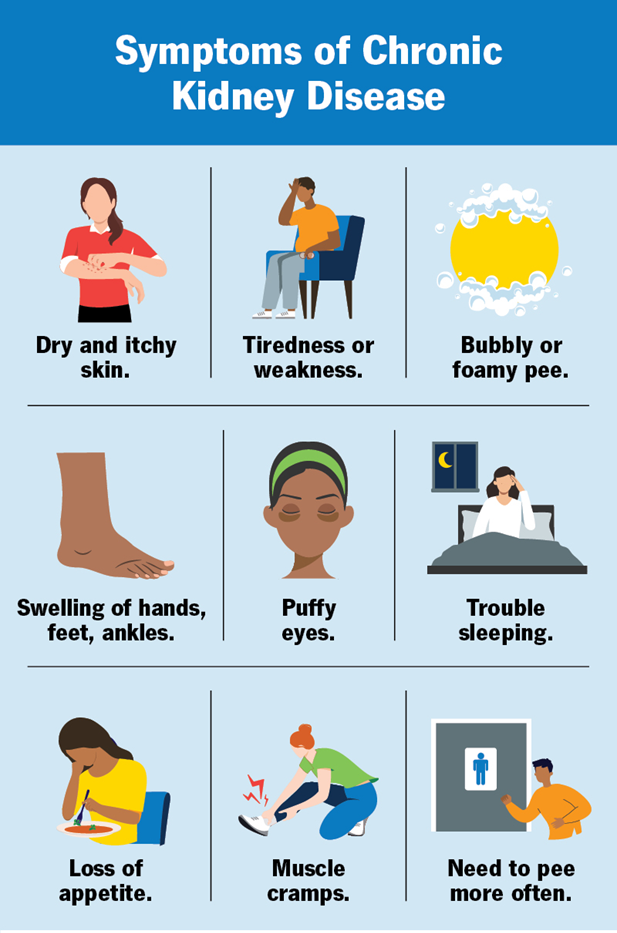Which clinical manifestation would be seen in a child with chronic renal failure?
Hypokalemia
Oliguria
Hypotension
Massive hematuria
The Correct Answer is B
Choice A reason:
Hypokalemia, or low potassium levels, is not typically associated with chronic renal failure. In fact, chronic renal failure often leads to hyperkalemia, which is an elevated level of potassium in the blood. This occurs because the kidneys are unable to excrete potassium effectively, leading to its accumulation in the body. Therefore, hypokalemia is not a clinical manifestation of chronic renal failure.
Choice B reason:
Oliguria, or reduced urine output, is a common clinical manifestation of chronic renal failure2. As the kidneys lose their ability to filter and excrete waste products, urine production decreases. This reduction in urine output is a key indicator of declining kidney function and is often observed in children with chronic renal failure. Monitoring urine output is crucial in assessing the progression of the disease and the effectiveness of treatment.

Choice C reason:
Hypotension, or low blood pressure, is not typically seen in chronic renal failure. Instead, hypertension, or high blood pressure, is more commonly associated with chronic renal failure. The kidneys play a crucial role in regulating blood pressure, and when they are not functioning properly, it can lead to an increase in blood pressure. Therefore, hypotension is not a clinical manifestation of chronic renal failure.
Choice D reason:
Massive hematuria, or the presence of a large amount of blood in the urine, is not a typical clinical manifestation of chronic renal failure. While hematuria can occur in some kidney conditions, it is not a defining feature of chronic renal failure. Chronic renal failure is more commonly associated with symptoms such as oliguria, fatigue, and swelling due to fluid retention.
Nursing Test Bank
Naxlex Comprehensive Predictor Exams
Related Questions
Correct Answer is B
Explanation
Choice A reason:
Adequate oxygenation is important in managing vaso-occlusive sickle cell crisis, but the replacement of factor V is not relevant to this condition. Factor V is involved in the blood clotting process, and its replacement is typically associated with bleeding disorders such as hemophilia. Therefore, this choice is not appropriate for managing a vaso-occlusive crisis.
Choice B reason:
Adequate hydration and pain management are critical components of care for a child in vaso-occlusive sickle cell crisis. Hydration helps to reduce the viscosity of the blood, which can prevent further sickling of red blood cells and improve blood flow. Pain management is essential because vaso-occlusive crises are extremely painful and require prompt and effective pain relief, often with opioid analgesics. These measures help to alleviate symptoms and prevent complications.
Choice C reason:
Pain management is indeed a crucial aspect of care for vaso-occlusive sickle cell crisis, but the administration of heparin is not typically part of the treatment. Heparin is an anticoagulant used to prevent blood clots, and it is not indicated for managing vaso-occlusive crises. The focus should be on hydration and pain relief rather than anticoagulation.
Choice D reason:
Correction of acidosis may be necessary in some cases, but it is not the primary focus of care for vaso-occlusive sickle cell crisis. The main goals are to manage pain and ensure adequate hydration to improve blood flow and reduce the risk of further sickling of red blood cells. While addressing acidosis can be part of the overall management, it is not the primary intervention.
Correct Answer is A
Explanation
Choice A reason:
Wearing cotton underpants is recommended to prevent urinary tract infections (UTIs) in young girls. Cotton is a breathable fabric that allows air to circulate, reducing moisture and creating an environment less conducive to bacterial growth. This helps to keep the genital area dry and clean, which is important in preventing UTIs.
Choice B reason:
Limiting trips to the bathroom is not recommended for preventing UTIs. In fact, it is important for young girls to urinate frequently to flush out bacteria from the urinary tract. Holding urine for extended periods can increase the risk of bacterial growth and infection. Therefore, encouraging regular bathroom trips is a better practice for preventing UTIs.
Choice C reason:
Decreasing salt intake is not directly related to preventing UTIs. While a healthy diet is important for overall health, there is no specific evidence linking salt intake to the prevention of urinary tract infections. The focus should be on practices that directly reduce the risk of bacterial growth and infection in the urinary tract.
Choice D reason:
Soaking in a bathtub, especially with bubble baths or perfumed soaps, can increase the risk of UTIs. These substances can irritate the urethra and create an environment conducive to bacterial growth. It is better to avoid prolonged baths with such products and instead opt for quick showers to maintain hygiene without increasing the risk of infection.
Whether you are a student looking to ace your exams or a practicing nurse seeking to enhance your expertise , our nursing education contents will empower you with the confidence and competence to make a difference in the lives of patients and become a respected leader in the healthcare field.
Visit Naxlex, invest in your future and unlock endless possibilities with our unparalleled nursing education contents today
Report Wrong Answer on the Current Question
Do you disagree with the answer? If yes, what is your expected answer? Explain.
Kindly be descriptive with the issue you are facing.
